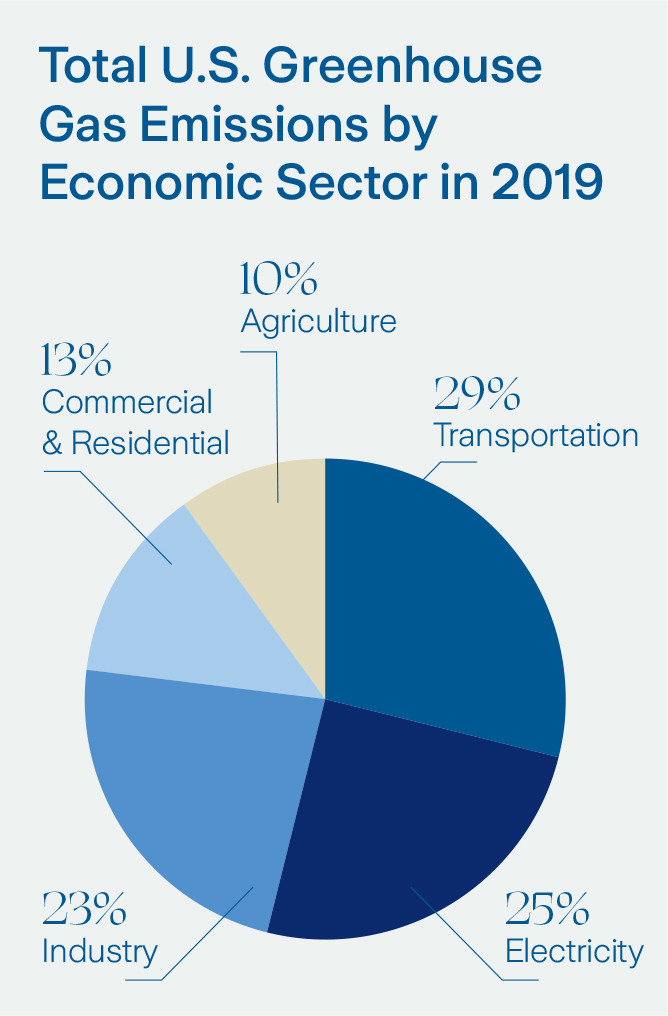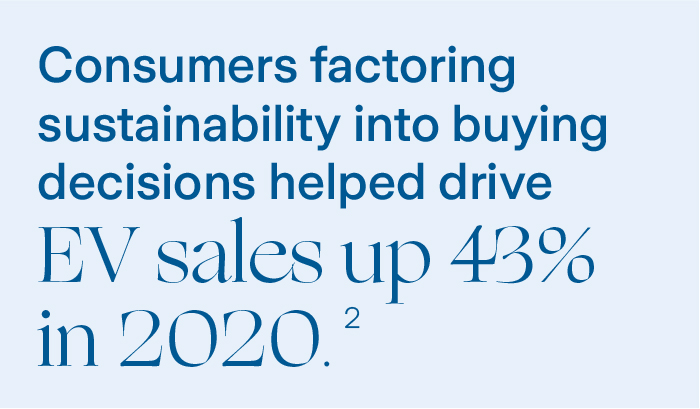Sustainability
The future is Electric
Sustainability-minded consumers, automakers move the electric vehicle market into overdrive
Increasing awareness of environmental issues caused by vehicles is one of the primary factors driving the growth of the global zero-emission vehicle market. As a result, reducing carbon emissions from vehicles has been identified as one of the key strategies in limiting climate change.
Within the transportation sector, more than half of greenhouse gas emissions come from passenger cars, medium- and heavy-duty trucks, and light-duty trucks, including sport utility vehicles, pickup trucks and minivans.1
Electric vehicles are an excellent solution to these problems as they do not emit pollutants as exhaust gas and most use renewable energy sources, such as solar, to power up, which in turn results in less dependence on fossil fuel. Reduction in pollutants in the environment also leads to cleaner air and fewer health problems, and electric vehicles can contribute to savings on fuel and maintenance costs.

All emission estimates from the Inventory of U.S. Greenhouse Gas Emissions and Sinks: 1990–2019. 1

Electric vehicles have become increasingly appealing to environmentally-conscious consumers, with an increasing number factoring sustainability — specifically clean, electric, software-connected vehicles — into their buying decisions.

Auto manufacturer-prioritization of zero-emission models has seen rapid adoption from some of the largest automakers across the globe. When, in January, General Motors announced it would sell only zero-emission vehicles by 2035, the bold pronouncement made major news in the U.S. and around the world. 2021 has seen a surprising number of manufacturers following suit.
- Carmakers worldwide will spend more than $268 billion through 2030 developing new electrified passenger vehicle models. Nine manufacturers have already announced plans to spend over $22 billion to open new or renovated plants in the U.S. to build EVs in five states. 3
- Between 2021 and 2023, the number of battery electric (BEV) and plug-in hybrid (PHEV) passenger vehicle models available to U.S. consumers will increase from 64 to 82. 3
- Bloomberg estimates that at least two-thirds of global car sales will be electric by 2040. 4
Automakers committed to zero-emission lines collectively own a large percentage of the U.S. market, and their switch to electric vehicles will have a major impact on emissions and vehicle trends in the U.S.
Electric vehicles have become a priority for an increasing number of consumers, and an even higher priority for automakers. Many car dealers are embracing the electric vehicle transition, and the excitement is warranted. The introduction of Ford’s debut of the F-150 Lightning pickup, an all-electric version of the best-selling vehicle line in the nation for four decades running. Ford.com tallied 70,000 reservations for the Lightning within the first week of its official release on May 19. That followed the successful introduction of Ford’s Mustang Mach-E electric vehicle, a launch for which 70% of initial customers were new to Ford. 5
Though there are unresolved questions about inventory management, sales and service training, and the impact on revenue generated through F&I and fixed operations, OEM commitment to producing electric vehicles and demand by sustainability-conscious businesses and consumers alike, gives dealers reason to embrace the evolution.
- https://www.epa.gov/ghgemissions/sources-greenhouse-gas-emissions All emission estimates from the Inventory of U.S. Greenhouse Gas Emissions and Sinks: 1990–2019.
- https://www.mckinsey.com/industries/automotive-and-assembly/our-insights/the-irresistible-momentum-behind-clean-electric-connected-mobility-four-key-trends#/signin/save
- https://www.mjbradley.com/sites/default/files/EDF_EV_Market_Report_April_2021_Update.pdf
- ftgthttps://www.bloomberg.com/news/articles/2021-08-09/at-least-two-thirds-of-global-car-sales-will-be-electric-by-2040
- https://www.cnbc.com/2021/06/13/gm-ford-are-all-in-on-evs-heres-how-dealers-feel-about-it-.html
_____________
4 DEALER PRINCIPAL
